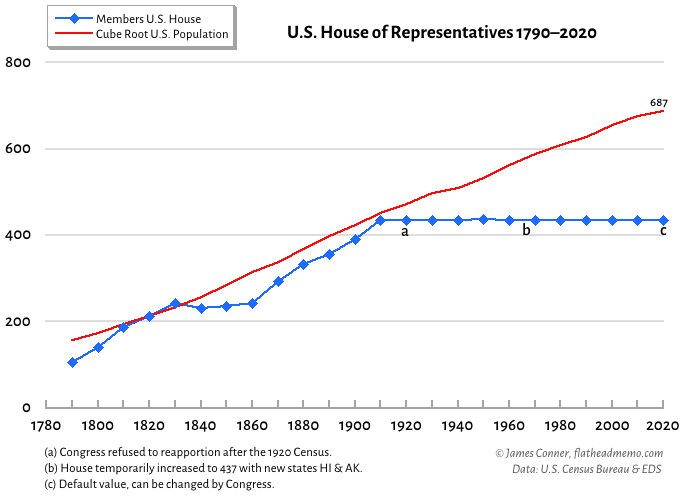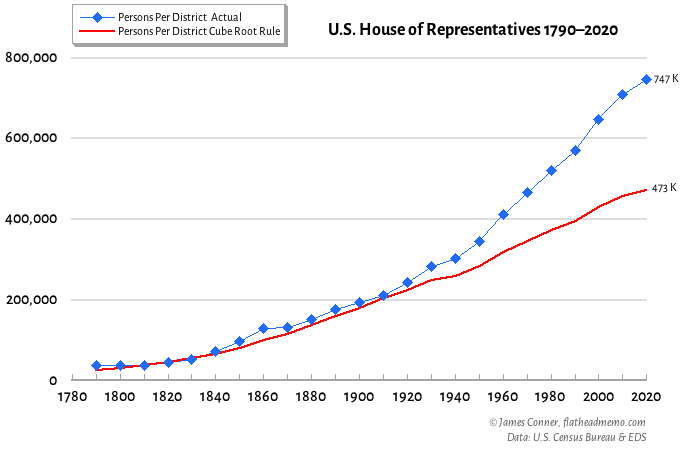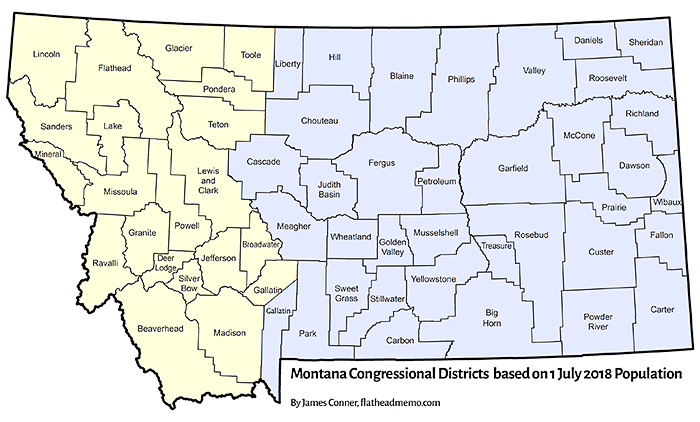31 December 2019 — 1912 mst
Enlarging the U.S. House of Representatives is the
best way for Montana to gain a second seat in the House
If the 2020 Census counts everyone in Montana, there’s a chance Montana will gain a second seat in the U.S. House when Congress is reapportioned next year. But I wouldn’t bet the ranch on that happening.
A second, and in my opinion, better, way to equip Montana with two seats in the U.S. House is increasing the number of representatives, which was set at 435 after the 1910 Census, the last time Congress increased the chamber’s size. I favor increasing the House to approximately 700 members. The New York Times’ America Needs a Bigger House illustrates how this might be done.
Note to those who think that 435 is set in constitutional stone. It isn’t. The House’s upper and lower bounds are set by Article I, Section 2.3, of the Constitution.
Representatives and direct Taxes shall be apportioned among the several States which may be included within this Union, according to their respective Numbers, … The Number of Representatives shall not exceed one for every thirty Thousand, but each State shall have at Least one Representative; and until such enumeration shall be made, the State of New Hampshire shall be entitled to chuse three, Massachusetts eight, Rhode Island and Providence Plantations one, Connecticut five, New York six, New Jersey four, Pennsylvania eight, Delaware one, Maryland six, Virginia ten, North Carolina five, South Carolina five, and Georgia three.
The theoretical lower bound is not 50. It is, rather, 50 plus the lowest number of members necessary to comply with the Constitution’s requirement for proportionality. The theoretical upper bound is the sum of the integer values of each state’s population divided by 30,000. For 2018 and 2019, that sum is approximately 10,900.
The Wyoming and cube root rules
At least two schemes have been devised to base the size of the House on a function of the nation’s population: the Wyoming rule, and the cube root rule.
The Wyoming rule sets the size by dividing the nation’s population by the population of the smallest state, at present Wyoming. Using the Census Bureau’s estimates for 2019, the Wyoming rule sets the House at 560 members. But as explained at Fair Vote and elsewhere, the Wyoming rule has problems.
The Wyoming Rule’s ideals of equity seem reasonable, but it neither tracks overall population nor does it protect against the possibility of the House becoming huge. In fact, if the Wyoming Rule been used in 1920, the House would have had 1,360 Members, and that number would have decreased every decade until 1990, even as the population grew.
The cube root rule is derived from observations that the the size of many national parliaments approximates the cube root of that nation’s population (see the 2016 Population and Legislative Body Size graph at the University of Virginia’s Stat Chat). For 2019, the cube root of the USA’s population is 688. If the cube root rule is applied to total of both chambers of Congress, our bicameral national legislature, the House’s membership is the cube root minus the size of the Senate. That formulation sets the House to 588 members.
If the rule is applied only to the House, to the chamber based on one person, one vote, the size is 688 members. Were the House enlarged to 588 or 688 members, Montana would pick up a second seat. I believe the cube root rule should be applied only to the House, as the Senate’s representational scheme is one state, two votes.
How might Montana be divided into two congressional districts?
The NY Times has a weird solution. Here’s my quick and dirty solution, based on population estimates for 1 July 2018. I suspect this is very close to what would be adopted if Montana gets a second seat. Note that Bozeman would be in the eastern district.
Montana can improve its odds of obtaining a second seat by (a) counting everyone who appears to be alive, and everyone who appears not to be permanently dead, (b) not leaving Montana, and (c) urging people to move to Montana ASAP. The count occurs in March. Therefore, procreating like crazy is no longer an option for improving the odds that the 2020 Census will produce a second member of the U.S. House for Montana.



